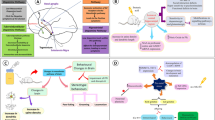Reduced daylight duration causes the development of seasonal affective disorder (SAD; depression-like disorders characterized by depressed mood, apathy, bulimia, and weight gain) in sensitive individuals. Neurotransmitter serotonin (5-HT) is involved in the mechanism of SAD. Zebrafish (D. rerio) is a promising model for translational studies. We studied changes in the behavior, content of 5-HT and its major metabolite 5-hydroxyindoleacetic acid (5-HIAA), and the expression of genes encoding the key enzymes of 5-HT metabolism, tryptophan hydroxylases TPH1A, TPH1B, TPH2, monoamine oxidase (MAO), 5-HT transporter, and 5-HT1A and 5-HT2A receptors in the brain of zebrafish reared for 60 days under short (04:20 h) compared to those reared at normal (12:12 h) photoperiod. Exposure to short photoperiod decreased locomotor activity in the novel tank diving test, increased the level 5-HIAA, and reduced the level of Mao gene mRNA, but did not affect the level of 5-HT and expression of Tph1a, Tph1b, Tph2, Slc6a4a (transporter), Htr1aa, and Htr2aa (receptors) genes. Thus, zebrafish can be used as a promising model to study the involvement of 5-HT in the SAD mechanism.
Similar content being viewed by others
References
Khotskin NV, Bajenova EY, Kulikova EA, Sorokin IE, Kulikov AV. The effect of the C1473G polymorphism in the tryptophan hydroxylase 2 gene as well as of the daylight period on mice behavior. Zh. Vyssh. Nervn. Deyat. 2019;69(1):78-87. Russian.
Bazhenova EY, Bazovkina DV, Kulikova EA, Fursenko DV, Khotskin NV, Lichman DV, Kulikov AV. C1473G polymorphism in mouse tryptophan hydroxylase-2 gene in the regulation of the reaction to emotional stress. Neurosci. Lett. 2017;640:105-110. doi: https://doi.org/10.1016/j.neulet.2017.01.010
Bazhenova EY, Fursenko DV, Kulikova EA, Khotskin NV, Sinyakova NA, Kulikov AA. Effect of photoperiodic alterations on depression-like behavior and the brain serotonin system in mice genetically different in tryptophan hydroxylase 2 activity. Neurosci. Lett. 2019;699:91-96. doi: https://doi.org/10.1016/j.neulet.2019.01.041
Evsiukova VS, Bazovkina D, Bazhenova E, Kulikova EA, Kulikov AV. Tryptophan hydroxylase 2 deficiency modifies the effects of fluoxetine and pargyline on the behavior, 5-HT- and BDNF-systems in the brain of zebrafish (Danio rerio). Int. J. Mol. Sci. 2021;22(23):12851. doi: https://doi.org/10.3390/ijms222312851
Gaspar P, Lillesaar C. Probing the diversity of serotonin neurons. Philos. Trans. R. Soc. Lond. B. Biol. Sci. 2012;367:2382-2394. doi: https://doi.org/10.1098/rstb.2011.0378
Gupta A, Sharma PK, Garg VK, Singh AK, Mondal SC. Role of serotonin in seasonal affective disorder. Eur. Rev. Med. Pharmacol. Sci. 2013;17(1):49-55.
Kalueff AV, Stewart AM, Gerlai R. Zebrafish as an emerging model for studying complex brain disorders. Trends Pharmacol. Sci. 2014;35(2):63-75. doi: https://doi.org/10.1016/j.tips.2013.12.002
Kulikova EA, Kulikov AV. Tryptophan hydroxylase 2 as a therapeutic target for psychiatric disorders: focus on animal models. Expert Opin. Ther. Targets. 2019;23(8):655-667. doi: https://doi.org/10.1080/14728222.2019.1634691
Kulikov AV, Popova NK. Tryptophan hydroxylase 2 in seasonal affective disorder: underestimated perspectives? Rev. Neurosci. 2015;26(6):679-690. doi: https://doi.org/10.1515/revneuro-2015-0013
Kulikov A, Sinyakova N, Kulikova E, Khomenko T, Salakhutdinov N, Kulikov V, Volcho K. Effects of acute and chronic treatment of novel psychotropic drug, 8-(trifluoromethyl)-1, 2, 3, 4, 5-benzopentathiepin-6-amine hydrochloride (TC-2153), on the behavior of Zebrafish (Danio rerio): a comparison with fluoxetine. Lett. Drug Design Discov. 2019; 16(12):1321-1328. doi: https://doi.org/10.2174/1570180816666190221162952
Levitan RD. The chronobiology and neurobiology of winter seasonal affective disorder. Dialogues Clin. Neurosci. 2007;9(3):315-324. doi: https://doi.org/10.31887/DCNS.2007.9.3/rlevitan
Miller AL. Epidemiology, etiology, and natural treatment of seasonal affective disorder. Altern. Med. Rev. 2005;10(1):5-13.
Molnar E, Lazary J, Benko A, Gonda X, Pap D, Mekli K, Juhasz G, Kovacs G, Kurimay T, Rihmer Z, Bagdy G. Seasonality and winter-type seasonal depression are associated with the rs731779 polymorphism of the serotonin-2A receptor gene. Eur. Neuropsychopharmacol. 2010;20(9):655-662. doi: https://doi.org/10.1016/j.euroneuro.2010.04.009
Otsuka T, Kawai M, Togo Y, Goda R, Kawase T, Matsuo H, Iwamoto A, Nagasawa M, Furuse M, Yasuo S. Photoperiodic responses of depression-like behavior, the brain serotonergic system, and peripheral metabolism in laboratory mice. Psychoneuroendocrinology. 2014;40:37-47. doi: https://doi.org/10.1016/j.psyneuen.2013.10.013
Walther DJ, Peter JU, Bashammakh S, Hörtnagl H, Voits M, Fink H, Bader M. Synthesis of serotonin by a second tryptophan hydroxylase isoform. Science. 2003;299:76. doi: https://doi.org/10.1126/science.1078197
Author information
Authors and Affiliations
Corresponding author
Additional information
Translated from Byulleten’ Eksperimental’noi Biologii i Meditsiny, Vol. 173, No. 3, pp. 279-284, March, 2022
Rights and permissions
About this article
Cite this article
Sorokin, I.E., Evsyukova, V.S. & Kulikov, A.V. Effect of Short Photoperiod on the Behavior and Brain Serotonin System in Zebrafish Danio rerio. Bull Exp Biol Med 173, 293–297 (2022). https://doi.org/10.1007/s10517-022-05536-w
Received:
Published:
Issue Date:
DOI: https://doi.org/10.1007/s10517-022-05536-w




